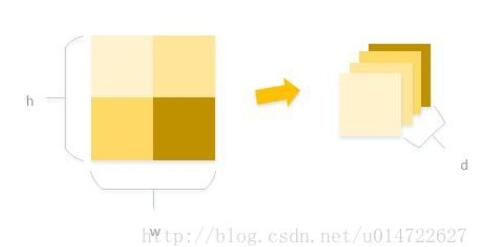tensorflow学习笔记之mnist的卷积神经网络实例
mnist的卷积神经网络例子和上一篇博文中的神经网络例子大部分是相同的。但是CNN层数要多一些,网络模型需要自己来构建。
程序比较复杂,我就分成几个部分来叙述。
首先,下载并加载数据:
import tensorflow as tf
import tensorflow.examples.tutorials.mnist.input_data as input_data
mnist = input_data.read_data_sets("MNIST_data/", one_hot=True) #下载并加载mnist数据
x = tf.placeholder(tf.float32, [None, 784]) #输入的数据占位符
y_actual = tf.placeholder(tf.float32, shape=[None, 10]) #输入的标签占位符
定义四个函数,分别用于初始化权值W,初始化偏置项b, 构建卷积层和构建池化层。
#定义一个函数,用于初始化所有的权值 W def weight_variable(shape): initial = tf.truncated_normal(shape, stddev=0.1) return tf.Variable(initial) #定义一个函数,用于初始化所有的偏置项 b def bias_variable(shape): initial = tf.constant(0.1, shape=shape) return tf.Variable(initial) #定义一个函数,用于构建卷积层 def conv2d(x, W): return tf.nn.conv2d(x, W, strides=[1, 1, 1, 1], padding='SAME') #定义一个函数,用于构建池化层 def max_pool(x): return tf.nn.max_pool(x, ksize=[1, 2, 2, 1],strides=[1, 2, 2, 1], padding='SAME')
接下来构建网络。整个网络由两个卷积层(包含激活层和池化层),一个全连接层,一个dropout层和一个softmax层组成。
#构建网络
x_image = tf.reshape(x, [-1,28,28,1]) #转换输入数据shape,以便于用于网络中
W_conv1 = weight_variable([5, 5, 1, 32])
b_conv1 = bias_variable([32])
h_conv1 = tf.nn.relu(conv2d(x_image, W_conv1) + b_conv1) #第一个卷积层
h_pool1 = max_pool(h_conv1) #第一个池化层
W_conv2 = weight_variable([5, 5, 32, 64])
b_conv2 = bias_variable([64])
h_conv2 = tf.nn.relu(conv2d(h_pool1, W_conv2) + b_conv2) #第二个卷积层
h_pool2 = max_pool(h_conv2) #第二个池化层
W_fc1 = weight_variable([7 * 7 * 64, 1024])
b_fc1 = bias_variable([1024])
h_pool2_flat = tf.reshape(h_pool2, [-1, 7*7*64]) #reshape成向量
h_fc1 = tf.nn.relu(tf.matmul(h_pool2_flat, W_fc1) + b_fc1) #第一个全连接层
keep_prob = tf.placeholder("float")
h_fc1_drop = tf.nn.dropout(h_fc1, keep_prob) #dropout层
W_fc2 = weight_variable([1024, 10])
b_fc2 = bias_variable([10])
y_predict=tf.nn.softmax(tf.matmul(h_fc1_drop, W_fc2) + b_fc2) #softmax层
网络构建好后,就可以开始训练了。
cross_entropy = -tf.reduce_sum(y_actual*tf.log(y_predict)) #交叉熵
train_step = tf.train.GradientDescentOptimizer(1e-3).minimize(cross_entropy) #梯度下降法
correct_prediction = tf.equal(tf.argmax(y_predict,1), tf.argmax(y_actual,1))
accuracy = tf.reduce_mean(tf.cast(correct_prediction, "float")) #精确度计算
sess=tf.InteractiveSession()
sess.run(tf.initialize_all_variables())
for i in range(20000):
batch = mnist.train.next_batch(50)
if i%100 == 0: #训练100次,验证一次
train_acc = accuracy.eval(feed_dict={x:batch[0], y_actual: batch[1], keep_prob: 1.0})
print 'step %d, training accuracy %g'%(i,train_acc)
train_step.run(feed_dict={x: batch[0], y_actual: batch[1], keep_prob: 0.5})
test_acc=accuracy.eval(feed_dict={x: mnist.test.images, y_actual: mnist.test.labels, keep_prob: 1.0})
print "test accuracy %g"%test_acc
Tensorflow依赖于一个高效的C++后端来进行计算。与后端的这个连接叫做session。一般而言,使用TensorFlow程序的流程是先创建一个图,然后在session中启动它。
这里,我们使用更加方便的InteractiveSession类。通过它,你可以更加灵活地构建你的代码。它能让你在运行图的时候,插入一些计算图,这些计算图是由某些操作(operations)构成的。这对于工作在交互式环境中的人们来说非常便利,比如使用IPython。
训练20000次后,再进行测试,测试精度可以达到99%。
完整代码:
# -*- coding: utf-8 -*-
"""
Created on Thu Sep 8 15:29:48 2016
@author: root
"""
import tensorflow as tf
import tensorflow.examples.tutorials.mnist.input_data as input_data
mnist = input_data.read_data_sets("MNIST_data/", one_hot=True) #下载并加载mnist数据
x = tf.placeholder(tf.float32, [None, 784]) #输入的数据占位符
y_actual = tf.placeholder(tf.float32, shape=[None, 10]) #输入的标签占位符
#定义一个函数,用于初始化所有的权值 W
def weight_variable(shape):
initial = tf.truncated_normal(shape, stddev=0.1)
return tf.Variable(initial)
#定义一个函数,用于初始化所有的偏置项 b
def bias_variable(shape):
initial = tf.constant(0.1, shape=shape)
return tf.Variable(initial)
#定义一个函数,用于构建卷积层
def conv2d(x, W):
return tf.nn.conv2d(x, W, strides=[1, 1, 1, 1], padding='SAME')
#定义一个函数,用于构建池化层
def max_pool(x):
return tf.nn.max_pool(x, ksize=[1, 2, 2, 1],strides=[1, 2, 2, 1], padding='SAME')
#构建网络
x_image = tf.reshape(x, [-1,28,28,1]) #转换输入数据shape,以便于用于网络中
W_conv1 = weight_variable([5, 5, 1, 32])
b_conv1 = bias_variable([32])
h_conv1 = tf.nn.relu(conv2d(x_image, W_conv1) + b_conv1) #第一个卷积层
h_pool1 = max_pool(h_conv1) #第一个池化层
W_conv2 = weight_variable([5, 5, 32, 64])
b_conv2 = bias_variable([64])
h_conv2 = tf.nn.relu(conv2d(h_pool1, W_conv2) + b_conv2) #第二个卷积层
h_pool2 = max_pool(h_conv2) #第二个池化层
W_fc1 = weight_variable([7 * 7 * 64, 1024])
b_fc1 = bias_variable([1024])
h_pool2_flat = tf.reshape(h_pool2, [-1, 7*7*64]) #reshape成向量
h_fc1 = tf.nn.relu(tf.matmul(h_pool2_flat, W_fc1) + b_fc1) #第一个全连接层
keep_prob = tf.placeholder("float")
h_fc1_drop = tf.nn.dropout(h_fc1, keep_prob) #dropout层
W_fc2 = weight_variable([1024, 10])
b_fc2 = bias_variable([10])
y_predict=tf.nn.softmax(tf.matmul(h_fc1_drop, W_fc2) + b_fc2) #softmax层
cross_entropy = -tf.reduce_sum(y_actual*tf.log(y_predict)) #交叉熵
train_step = tf.train.GradientDescentOptimizer(1e-3).minimize(cross_entropy) #梯度下降法
correct_prediction = tf.equal(tf.argmax(y_predict,1), tf.argmax(y_actual,1))
accuracy = tf.reduce_mean(tf.cast(correct_prediction, "float")) #精确度计算
sess=tf.InteractiveSession()
sess.run(tf.initialize_all_variables())
for i in range(20000):
batch = mnist.train.next_batch(50)
if i%100 == 0: #训练100次,验证一次
train_acc = accuracy.eval(feed_dict={x:batch[0], y_actual: batch[1], keep_prob: 1.0})
print('step',i,'training accuracy',train_acc)
train_step.run(feed_dict={x: batch[0], y_actual: batch[1], keep_prob: 0.5})
test_acc=accuracy.eval(feed_dict={x: mnist.test.images, y_actual: mnist.test.labels, keep_prob: 1.0})
print("test accuracy",test_acc)
以上就是本文的全部内容,希望对大家的学习有所帮助,也希望大家多多支持【听图阁-专注于Python设计】。
